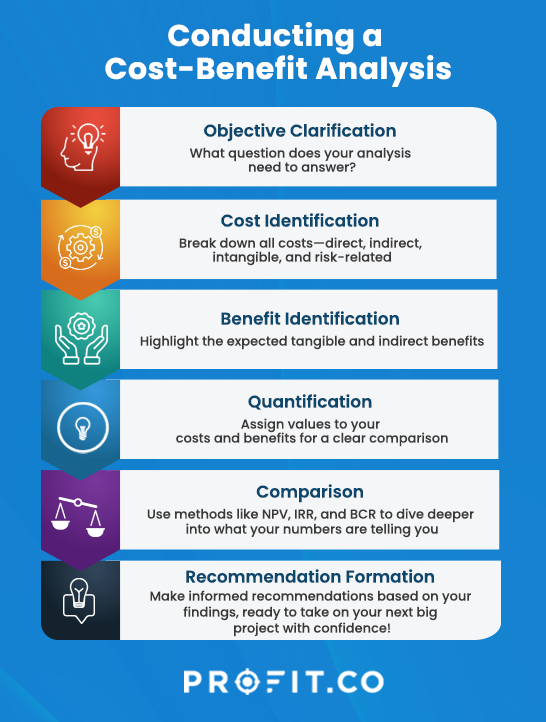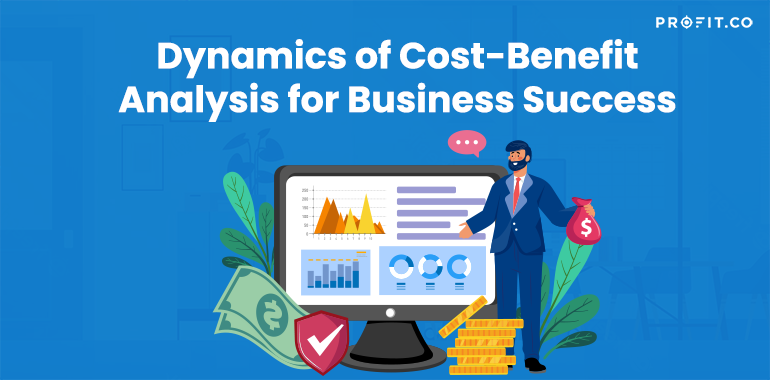At its core, CBA involves thoroughly examining all aspects of a decision—assessing the advantages and disadvantages of various courses of action, whether launching a new line of products or adopting sustainability measures in your operations. CBA proves valuable across a spectrum of scenarios—for a governmental organization deliberating on policy reforms, a corporate entity strategizing business moves, or an entrepreneur plotting the next big leap. It provides a quantifiable and objective framework for decision-making.
Understanding Cost-Benefit Analysis
Cost-benefit analysis (CBA) is a quantitative tool enabling organizations to evaluate the feasibility of decisions regarding projects, policies, programs, or various initiatives.
This method involves a thorough assessment of the costs and benefits associated with a particular choice, comparing these to ascertain if the advantages supersede the costs. When benefits exceed costs, the decision may be favorable. This technique aids in predicting outcomes of resource allocation and discerning the potential gains and losses from specific decisions.
The versatility of CBA is evident in its two principal uses.
- It serves as a tool to validate the soundness of an investment or decision, effectively acting as a financial audit of your options to verify if the benefits justify the costs.
- CBA functions as a comparative mechanism, enabling a side-by-side evaluation of multiple alternatives to identify the optimum balance of cost and benefit
Though the premise of cost-benefit analysis appears straightforward, its application is nuanced, revealing its complexity upon deeper exploration.
“Customers want high quality at low prices and they want it now.”
Optimal Conditions for Using Cost-Benefit Analysis
Given its resource-intensive nature, cost-benefit analysis is best applied to decisions with significant financial or strategic implications, ideally where inputs and outputs are quantifiable.
Scenarios ripe for a CBA include:
- Major investments
- Project launches
- Strategy development
- Resource allocation optimization
- Evaluating policy impacts on business
- Regulatory effects forecasting
Additionally, in human resources contexts, CBAs can play a crucial role in hiring, training, compensation, and investments in HR technologies, helping to evaluate the impact of new hires, training programs, and technology investments on organizational efficiency and growth.
Explore the benefits of Cost-Benefit Analysis for Business Success!
Making the Right Choice: Assessing Costs and Benefits
Before diving headfirst into a project or decision, weighing the potential gains against the required investments is crucial. Cost-benefit analysis provides a powerful framework to make informed choices.
Let’s explore some key methods used to assess costs and benefits:
Net Present Value (NPV)
Imagine a crystal ball that shows the present-day value of your future earnings. NPV does exactly that by discounting future cash flows to reflect their worth in today’s dollars. It considers the initial investment and calculates the project’s overall profitability, giving you a clear picture of its true value.
Benefit-Cost Ratio (BCR)
Think of BCR as a scorecard that measures a project’s efficiency. It compares the total benefits to the total costs, revealing how much “bang you get for your buck.” A BCR greater than 1 indicates that the benefits outweigh the costs, making it a potentially worthwhile endeavor.
Internal Rate of Return (IRR)
Imagine a magic discount rate that makes a project’s NPV equal zero. That’s precisely what IRR calculates. It essentially tells you the expected return rate on your investment over the project’s lifespan. Generally, a higher IRR suggests a more attractive investment opportunity.
Payback Period
How quickly can you recoup your investment? Payback period answers this question. It calculates the time it takes for the project’s benefits to cover the initial costs. A shorter payback period signifies a faster return on investment, making it a potentially appealing option.
Sensitivity Analysis
The Future Isn’t Set in Stone Even the best plans can encounter unexpected bumps. Sensitivity analysis helps you navigate uncertainty. It involves adjusting key variables and assumptions to see how these changes impact the project’s outcomes. By exploring various scenarios, you gain a deeper understanding of potential risks and how they might affect costs, benefits, and overall viability. This empowers you to make more robust decisions.
Conducting a Cost-Benefit Analysis
A cost-benefit analysis involves a structured approach, typically spanning six steps to facilitate data-driven decision-making.

A real-world example of a Cost-Benefit Analysis (CBA)
A real-world example of a Cost-Benefit Analysis (CBA) can be seen in the decision-making process for a city’s public transportation upgrade project. This example will illustrate how a city evaluates the feasibility and potential impact of investing in a new light rail system versus upgrading the existing bus fleet.
Background
The city is facing increased traffic congestion, environmental concerns, and the need for efficient public transportation to support its growing population. City planners are considering two main options: investing in a new light rail system or upgrading the existing bus fleet to electric buses.
Step 1: Define the Objective
The primary goal is to determine the most cost-effective and beneficial solution for enhancing the city’s public transportation system, reducing traffic congestion, minimizing environmental impact, and improving residents’ quality of life.
Step 2: Identify Costs
Light Rail System Costs:
- Capital costs for construction of tracks, stations, and purchase of trains.
- Operating and maintenance costs.
- Disruption to the city during construction.
Bus Fleet Upgrade Costs:
- Purchase of electric buses.
- Infrastructure for charging stations.
- Operating and maintenance costs.
Step 3: Identify Benefits
Light Rail System Benefits:
- Reduced traffic congestion.
- Lower environmental impact compared to buses.
- Potential to attract new businesses and increase property values along the route.
Bus Fleet Upgrade Benefits:
- Quick implementation compared to constructing a rail system.
- Flexibility in routes to adapt to changing city dynamics.
- Reduced pollution compared to traditional buses.
Step 4: Quantify Costs and Benefits
Costs and benefits are quantified over a projected period, say 20 years, considering inflation, maintenance, operational expenses, and anticipated revenue from ticket sales or reduced healthcare costs due to lower pollution levels.
Step 5: Compare Total Costs and Benefits
The analysis involves calculating the Net Present Value (NPV), Internal Rate of Return (IRR), and Benefits-Cost Ratio (BCR) for both options. For simplicity, assume the light rail system has higher initial costs but offers greater long-term benefits due to reduced operational costs and increased economic activity. The upgraded bus system shows lower initial costs and faster implementation benefits but may need to address long-term congestion more effectively.
Step 6: Make Recommendation
Based on the CBA, if the light rail system presents a positive NPV, a BCR greater than 1, and an acceptable IRR compared to the city’s benchmark, it may be recommended despite its higher initial costs due to its long-term benefits and sustainability. However, considerations such as funding availability, political will, and public opinion must also be taken into account.
Real-World Application
Cities like Portland, Oregon, and Charlotte, North Carolina, have undertaken similar analyses when deciding to invest in light rail systems, weighing the upfront costs against long-term benefits including reduced traffic congestion, environmental benefits, and economic development along the rail lines.
In this example, the CBA provided a structured framework for assessing the financial viability and broader impacts of two significant transportation options, enabling decision-makers to make an informed choice that aligns with the city’s strategic goals and public interests.
Other Illustrative examples, such as decisions between software upgrades or new solutions, hiring additional staff, and launching wellness programs, demonstrate the practical application of cost-benefit analysis in making informed business decisions.
Keys to a Successful Cost-Benefit Analysis
Achieving a successful cost-benefit analysis hinges on thorough planning, stakeholder consultation, and maintaining simplicity and accuracy. It’s crucial to start the analysis during the project planning phase and consider a wide range of perspectives to ensure a comprehensive evaluation.
While cost-benefit analysis is vital for data-driven decision-making, facilitating stakeholder buy-in, and promoting objectivity, it has limitations. Challenges include the potential for data inaccuracies, complexity, and a focus that may be too narrow financially, possibly overlooking broader concerns such as reputation, employee satisfaction, and environmental impact.
Final Thoughts
In essence, cost-benefit analysis equips businesses to judiciously evaluate decision-making, assigning monetary values to both the costs and potential benefits of actions. By adopting CBA methodologies, companies can make decisions that enhance their operational health and navigate the complexities of the market with greater precision and confidence.
Learn how to balance costs and benefits to achieve optimal outcomes effectively
Related Articles
-
Understanding Parkinson’s Law and Its Impact on Productivity
We all know the drill: “We’ve got plenty of time.” A project, a presentation, a new initiative we give ourselves... Read more
-
Can the Pomodoro Technique Improve Your Productivity and Time Management?
Your to-do list is staring at you. You’re staring back. A silent standoff. You know what needs to get done,... Read more
-
Understanding and Managing Risk Exposure Index (REI)
Risk Exposure is a vital Key Performance Indicator (KPI) in project management. It measures the potential impact of risks by... Read more
-
10 Essential Task Delegation Tips Every Manager Should Know
Ah, delegation—the age-old management dilemma. On one hand, it's the key to unlocking team potential, driving efficiency, and fostering professional... Read more

